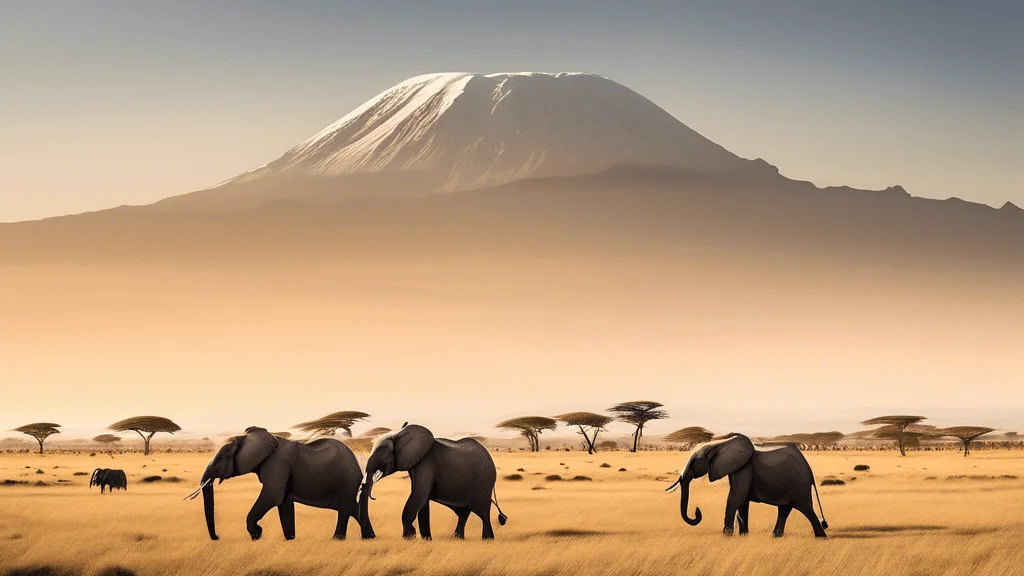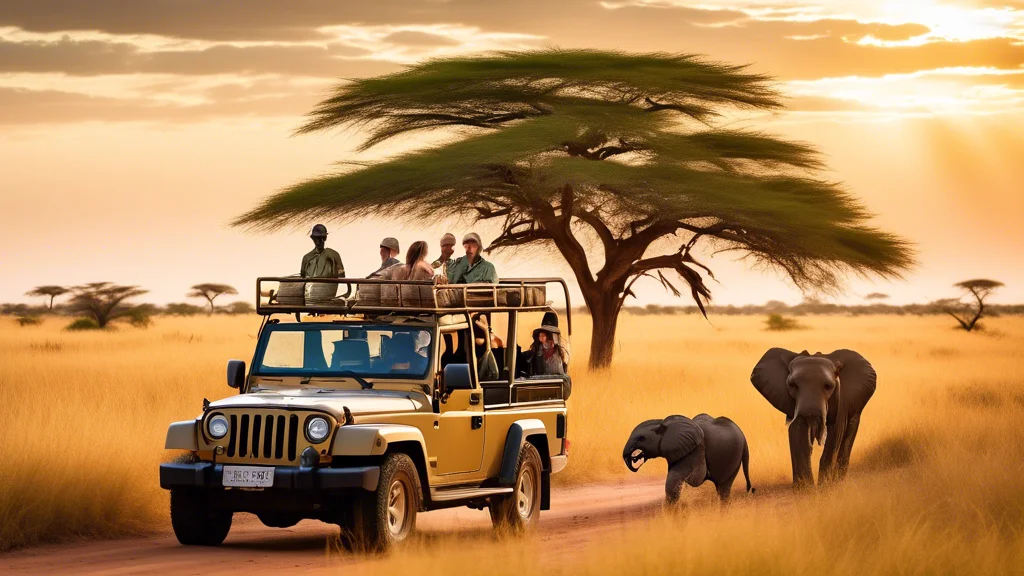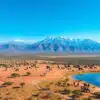Discover Amboseli National Park: Land of Giants
Have you ever dreamed of witnessing the grandeur of Africa’s wild landscapes, with the world’s tallest free-standing mountain as your backdrop? If your answer is a resounding yes, then Amboseli National Park should be at the top of your travel list. Nestled in the heart of kenya Kenya, this iconic park is a paradise for wildlife enthusiasts and nature lovers alike.
Why is Amboseli so special, you ask? For starters, it’s famously known as the Land of Giants. This enchanting nickname pays homage to its magnificent elephant population – some of the largest on the planet. Imagine standing face-to-face with these gentle giants, their tusks gleaming under the African sun, with the snow-capped peaks of Mount Kilimanjaro towering in the distance. It’s the kind of scene you often see in wildlife documentaries but rarely in person.
But the magic of Amboseli doesn’t stop there. The park is a jewel in the crown of kenya Kenya’s natural treasures, attracting thousands of visitors from around the globe each year. Whether it’s your first safari or you’re a seasoned explorer, Amboseli’s unique blend of dramatic landscapes, diverse ecosystems, and abundant wildlife offers an unforgettable adventure.
The origins of the name Land of Giants trace back to both the imposing presence of these majestic elephants and the sweeping views of the mighty Kilimanjaro. Over the years, this name has become synonymous with the profound sense of wonder and awe that envelops every visitor. How could it not, with such a compelling combination of natural beauty and wildlife spectacle?
So, are you ready to embark on this adventure? Let’s dive deeper into what makes Amboseli National Park a destination like no other.
Introduction to Amboseli National Park
Overview of Amboseli National Park
Ah, Amboseli National Park! A haven for wildlife enthusiasts and adventure seekers alike. Nestled in the southern parts of kenya Kenya, this gem of a park spans around 392 square kilometers, making it relatively compact yet incredibly diverse. Picture this: vast savannas teeming with life, gently rolling hills, and, of course, the iconic backdrop of Mount Kilimanjaro. It’s like stepping into a real-life National Geographic documentary.
Why is Amboseli so special, you ask? Well, it’s renowned for its unparalleled opportunities to observe free-ranging elephants. Imagine standing just meters away from these majestic giants, capturing their every move with your camera. But we’ll dive deeper into that shortly. Combine that with the vibrant birdlife, and you’ve got a wildlife experience that’s hard to beat.
Significance and Popularity of the Park
No trip to kenya Kenya would be complete without visiting Amboseli, right? It’s not just a stop on the tourist circuit; it’s a must-see. The park’s popularity isn’t a recent phenomenon either. Tourists, photographers, and researchers have been flocking to Amboseli for decades. In fact, its status as a UNESCO Biosphere Reserve since 1991 underscores its immense ecological and cultural importance.
Amboseli offers more than just wildlife. It’s a place where you can witness the symbiotic relationship between humans and nature. The Maasai people, who inhabit the area, have coexisted with the wildlife for centuries, and their rich cultural heritage adds another layer of intrigue to your visit. Trust me, when I visited, watching a Maasai warrior dance at sunset with Kilimanjaro in the background was something out of a dream.
Brief History and Origin of the Name Land of Giants
Ever wonder why it’s dubbed the Land of Giants? For this one, let’s take a little trip down memory lane. The park’s name, Amboseli, is derived from the Maasai word Empusel, meaning salty, dusty place. Before it became the celebrated sanctuary it is today, Amboseli was indeed a harsh, arid land. Still, the numerous springs fed by melting snow from Mount Kilimanjaro give life to its flora and fauna.
The Land of Giants nickname is no exaggeration. It’s no secret that Amboseli is synonymous with elephants. These aren’t just any elephants; they are some of the largest and most impressive you’ll ever encounter. I remember reading stories about Tim the Elephant, one of the biggest and most photographed elephants in Amboseli. He was like a celebrity! Unfortunately, Tim passed away recently, but his legacy lives on, symbolizing the grandeur and resilience of Amboseli’s giant residents.
This historical context and the majestic elephants make Amboseli not just a destination, but a legend in the annals of wildlife conservation. So, when are you planning your visit? Because trust me, you don’t want to miss this iconic slice of Africa.
Wildlife in Amboseli National Park
Iconic Elephant Population: The Giants of Amboseli
You know how sometimes you meet someone, and they just leave an impression that lasts a lifetime? That’s what the elephants of Amboseli do. These majestic giants are not just any elephants; they are some of the most iconic and studied elephant populations in the world. Picture this: massive elephants with incredible tusks, leisurely ambling through the open plains with Mount Kilimanjaro towering in the background. It’s not just a scene from a documentary; it’s real life in Amboseli National Park.
Why are these elephants so special? Well, for one, they’ve been the subject of one of the longest-running studies of elephant behavior and ecology. I remember visiting the park and being amazed by how the researchers could identify each elephant by name and personality. These giants feel almost like celebrities who’ve chosen to live in the wild instead of the Hollywood Hills.
Other Notable Wildlife: Lions, Cheetahs, Giraffes, Zebras, and Birds
But don’t let the elephants steal all the spotlight. Amboseli’s wildlife roster reads like the who’s who of the animal kingdom. Ever wanted to see a lion lounging in the shade or a cheetah darting through the grasslands? Amboseli has got you covered. Picture a pride of lions, basking in the morning sun, ready to start their day. Or imagine the sheer grace of a cheetah, hunting in the early dawn.
Let’s not forget the giraffes with their elegant necks reaching for the highest branches, and the zebras grazing in the wide open savannas. Personally, the first time I saw a dazzle of zebras (yep, that’s the collective noun!), I couldn’t help but marvel at their stunning patterns and social dynamics.
And oh, the birds! With over 400 species of birds, Amboseli is a birdwatcher’s paradise. From the majestic African Fish Eagle to the strikingly colorful Lilac-breasted Roller, there’s something to capture the eye at every turn. On my trip, I tried identifying the birds with a handy guidebook, but honestly, I often ended up just sitting back and enjoying the vibrant avian show.
Best Times and Seasons to View Wildlife
You might be wondering when’s the best time to pack your bags and head to Amboseli. Here’s the scoop: the wildlife viewing is superb year-round, but if you’re aiming for the crème de la crème experience, consider timing your visit during the dry seasons, which are from June to October and January to February.
During these months, the animals gather around the swamps and other water sources, making them easier to spot. Plus, the weather is usually mild and pleasant. I remember planning my trip in July, and it was perfect timing. The swamps were bustling with activity, and it was almost like the animals were putting on a show just for me.
If you’re an elephant enthusiast like myself, you might appreciate knowing that the Amboseli elephants are generally visible throughout the year. However, the dry season still offers a slight edge, as the sparse vegetation means animals are more out in the open.
In contrast, the wet season (November to May) brings lush scenery and dramatic skies, perfect for photography. The only downside? The tall grass can make some of the smaller animals a bit harder to spot. But hey, if lush, green landscapes with fewer visitors around is what you’re after, the wet season can be your friend.
This balance of seasons ensures that no matter when you visit, Amboseli National Park offers an unforgettable glimpse into the wondrous world of wildlife.
Unique Features of Amboseli National Park
Mount Kilimanjaro: The Majestic Backdrop
Imagine waking up to the sight of the highest free-standing mountain in the world – Mount Kilimanjaro. It’s not just a backdrop; it’s a dramatic statement. For many, the snow-capped peaks of Kilimanjaro are a surprise—who expects to see snow so close to the equator? One time, I remember a morning game drive when the clouds that usually shroud Kilimanjaro lifted, and there it was in its full glory. We got some of the best photos of our trip right then, with elephants silhouetted against the breathtaking mountain. Isn’t that a scene right out of a postcard?
Mount Kilimanjaro not only dominates the skyline but also plays a crucial role in the park’s ecosystems. The melting snow and rainfall from the mountain create underground rivers, which feed the swamps and wetlands in Amboseli. It’s a symphony of nature that supports an incredible variety of life.
Diverse Ecosystems: Swamps, Savannas, and Woodlands
Amboseli is not just a one-trick pony. Its variety of habitats ensures that no two days are the same. From the lush greenery of the swamps to the vast open savannas and dense woodlands, each ecosystem offers its own set of wonders. I’ll never forget the contrast of driving through a dry, arid plain only to find ourselves amid a green, vibrant swamp teeming with life. Who knew a swamp could be so fascinating?
The swamps, largely fed by those secretive underground rivers from Kilimanjaro, are essential lifelines for much of the park’s wildlife, especially during the dryer months. You’ll often find elephants wading through these marshlands, cooling off and splashing around like oversized toddlers at a water park. Don’t forget the birdlife—herons, egrets, and a myriad of other species all thrive here.
The savannas, on the other hand, offer those iconic African landscapes most of us envision when we think of a safari. This is where you’ll spot zebras grazing and giraffes stretching their necks to nibble on the highest leaves. The wide-open spaces also make it easier to spot the big cats on the hunt, giving photographers ample opportunity to capture some National Geographic-worthy action shots.
The wooded areas might seem less exciting at first glance, but they’re full of hidden treasures. These regions provide shelter and cool refuge for animals, especially during the scorching midday sun. Keep your eyes peeled for leopards lazing on tree branches or elephants using tree trunks as scratching posts.
Observation and Viewing Areas: Best Spots for Photography
Speaking of photography, Amboseli offers some of the best observation points to get that shot-of-a-lifetime. One of my personal favorites is the Observation Hill. It’s a bit of a climb, but trust me, the panoramic views from the top are worth every step. You can see the entire park unfurling before you—savannas, swamps, and all—under the gaze of Mount Kilimanjaro.
If you’re keen on bird watching, the swamps around Ol Tukai Lodge are an absolute must-visit. The sheer variety of species you’ll encounter here can make even a casual observer feel like an ornithologist. Grab your binoculars and a thermos of coffee, and you’re set for a morning of discovery.
For those sunset chasers, the opportunities are endless. I still have a prized photo taken near Lake Amboseli, with the sky ablaze in hues of orange and red, reflecting on the water with silhouetted elephants adding the perfect finishing touch. Whether you are using an iPhone or a professional DSLR, Amboseli ensures you return home with a memory card full of envy-inducing snapshots.
In short, Amboseli’s unique features make it a diverse paradise with something to offer for everyone. Whether you’re an avid photographer, a nature enthusiast, or just someone looking to take in some incredible scenery, this park has got you covered. So, have you packed your camera and sense of adventure yet?
Activities and Attractions
Safari Tours: Guided and Self-Driven Options
Let’s be honest, when you think of Africa, one of the first things that come to mind is a safari, right? Amboseli National Park offers both guided and self-driven safari tours, catering to all kinds of adventurers. I remember my first safari like it was yesterday – the adrenaline rush as we spotted a herd of elephants ambling gracefully against the backdrop of Mount Kilimanjaro was a sight to behold.
Guided safari tours are a fantastic way to soak in the beauty of the park without worrying about navigation or missing out on any exciting wildlife. These tours are led by experienced guides who know the park like the back of their hand. They share fascinating insights about the animals and their habitats, making the experience educational and thrilling. Plus, they have this uncanny ability to spot animals from what seems like miles away!
On the other hand, if you’re the kind of person who loves a bit of an adventure, self-driven tours are for you. There’s something uniquely exhilarating about having the freedom to explore at your own pace. The park is well-mapped, and with a reliable 4×4, you’re in for an unforgettable ride. Just don’t forget to pack some patience and a sense of wonder – the wildlife doesn’t run on a schedule, after all!
Cultural Visits: Maasai Villages and Local Communities
Beyond the wildlife, one of the most enriching experiences in Amboseli is visiting the Maasai villages. Ever wondered what it’s like to live like the Maasai, with their vibrant traditions and rich culture? These visits are your chance to find out.
The Maasai people are renowned for their colorful attire, intricate beadwork, and impressive jumping dances. During a cultural tour, you get the opportunity to interact with the community, learn about their way of life, and even participate in some of their daily activities. I still cherish the memory of trying my hand at milking a cow and surprisingly not failing miserably!
Such experiences are not only enjoyable but also eye-opening. They help you appreciate the deep connection the Maasai have with the land and the wildlife, and understand why conservation is so crucial to their way of life. Plus, it’s a great way to support the local economy, as proceeds from these tours directly benefit the communities.
Walking Trails and Bird Watching
If you’re a nature lover like me, you know there’s a different kind of magic in exploring on foot. Amboseli offers several walking trails, allowing you to immerse yourself in the park’s stunning landscapes and diverse ecosystems at a more intimate level.
Walking through the swamps, savannas, and woodlands with an experienced guide provides a completely different perspective compared to a safari vehicle. You notice the smaller details – the intricate patterns of animal tracks, the vibrant colors of the flora, and the subtle rustle of the wind through the grass. One of my favorite moments was spotting a family of dik-diks darting through the underbrush, almost camouflaged against the landscape. It’s these little, unexpected encounters that add an extra layer of wonder to your visit.
And let’s not forget the bird watching! Amboseli is a paradise for bird enthusiasts, with over 400 species to spot. From the vibrant plumage of the African jacana to the striking silhouette of the grey crowned crane, there’s always something to feast your eyes on. Bring a good pair of binoculars and you’re set for hours of relaxing, awe-inspiring observation.
So, whether you’re cruising through the park on a safari, immersing yourself in Maasai culture, or wandering the walking trails with your eyes peeled for birds, Amboseli National Park offers an array of activities and attractions that cater to every kind of explorer. Trust me, every moment spent in this ‘Land of Giants’ is a memory in the making.
Planning Your Visit
How to Get There: Transportation Options
So, you’ve decided to venture into the wild heart of kenya Kenya and can already picture the herds of elephants and the towering presence of Mount Kilimanjaro. But before you start dreaming about those little sundowners overlooking the savanna, there’s an important question to address: how do you actually get to Amboseli National Park?
First things first, Amboseli is conveniently located about 240 kilometres (150 miles) southeast of Nairobi. If you’re flying in from abroad, Jomo kenya Kenyatta International Airport in Nairobi is your likely landing spot. From Nairobi, you have a couple of travel options: by road or by air.
By Road
If you’re a fan of long drives and soaking in the scenic beauty of rural kenya Kenya, then hitting the road is a fantastic choice. You’d be surprised how much there is to see from the comfort of your car. Personally, I recall a drive filled with charming roadside markets, Maasai herders guiding their cattle, and children laughing and waving as we passed by.
You can embark on this road trip via the Mombasa Road (A109) to Emali and then take the Emali-Loitokitok Road (C102), which leads directly to the park. The journey takes approximately 4-5 hours, depending on traffic and road conditions. Just make sure you have a sturdy vehicle, preferably a 4×4, especially during the wet season, as road conditions can deteriorate quickly.
By Air
In a hurry or keen on cutting travel time? Small domestic airlines like Safarilink and Airkenya Kenya operate regular flights from Nairobi’s Wilson Airport to Amboseli’s airstrips. The flight takes just about 40 minutes, and before you know it, you’ll be landing right in the midst of the park, with Mount Kilimanjaro giving you an epic welcome.
Local Transfers
Once you’re in the park, most lodges and camps offer transfer services from airstrips to the accommodation. Always check with your lodge beforehand to confirm pickup arrangements. If you’re more of a DIY traveler, car rentals and taxi services are available as well.
Accommodation: Lodges, Campsites, and Resorts
Amboseli has a reputation for catering to diverse tastes and budgets when it comes to accommodation. Whether you’re looking for luxury, comfort, or just a place to crash between adventures, there’s something for everyone.
Lodges and Resorts
For those who want to experience Africa with a touch of elegance, the high-end lodges and resorts in Amboseli will not disappoint. Places like Ol Tukai Lodge and Amboseli Serena Safari Lodge offer an alluring blend of comfort, style, and stunning views. Picture this: you’re lounging on your private deck, a cool drink in hand, while watching a herd of elephants saunter by with Kilimanjaro as your backdrop. Sounds perfect, doesn’t it?
Budget-Friendly Campsites
For the budget-conscious traveler or the more adventurous soul, several campsites within and around the park offer a more rustic but equally enriching experience. From community-run camps to established sites like Amboseli Kimana Camp, these spots offer basic amenities but bring you closer to nature. There’s something magical about hearing the distant roars of lions under a starlit sky. I remember one night at a campsite where the sounds of the wild created a symphony that lulled me to sleep.
Eco-Friendly Choices
If sustainability is your mantra, then eco-lodges like Tortilis Camp can be your haven. These places focus on environmental conservation, blending luxury with a lower carbon footprint. You get the same breathtaking landscapes and wildlife encounters but with the added satisfaction of knowing you’re treading lightly on the earth.
Travel Tips and Safety Information
Before you pack your bags and set off on your dream safari, here are a few tips to ensure your trip is as smooth and enjoyable as possible.
Health Precautions
First, let’s talk health. Make sure your vaccinations are up-to-date, particularly for yellow fever, typhoid, and hepatitis. Don’t forget to pack a good mosquito repellent and consider taking malaria prophylactics – better safe than sorry, right?
What to Pack
Amboseli can be unpredictable weather-wise, so pack smart. Light clothing works for the daytime when it’s hot, but don’t forget a warm jacket for the cooler evenings and early mornings. A good pair of binoculars, a camera with a decent zoom lens, and plenty of memory cards are must-haves. Trust me, you don’t want to miss those once-in-a-lifetime shots! Comfortable walking shoes are also essential for those who plan to explore on foot.
Safety First
Wildlife is unpredictable, so always maintain a safe distance from animals. Listen to your guides – they’re experts and know how to keep you safe. Don’t wander off alone, especially in unfenced areas. And keep your windows rolled up when driving through the park.
Respect Local Cultures
Lastly, respect local cultures. The Maasai people, with their rich traditions and vibrant attire, are an integral part of the Amboseli experience. Engage respectfully, ask permission before taking photos, and consider purchasing local crafts to support the community.
So there you have it – a roadmap (literally) to planning your visit to Amboseli National Park. I hope you find these tips useful and that they ignite a spark to get out there and explore the Land of Giants. Happy travels!
Conclusion
So, there you have it—Amboseli National Park, an extraordinary blend of breathtaking landscapes, thrilling wildlife encounters, and rich cultural experiences. Whether you’re marveling at the iconic elephant herds or snapping photos of Mount Kilimanjaro in the backdrop, Amboseli offers a travel adventure like no other. It’s easy to see why this park is often referred to as the Land of Giants.
From the diversity of ecosystems to the opportunities for close encounters with nature, your trip here is bound to be unforgettable. You’ll revel in the thrill of guided safari tours or enjoy the freedom of a self-driven adventure. And let’s not forget the unique cultural exchanges with the Maasai people, adding another layer of enrichment to your visit.
Getting there? A breeze with numerous transportation options at your disposal. Accommodation ranges from cozy campsites under the stars to luxurious lodges that offer every comfort. With a bit of planning and attention to safety tips, your journey to Amboseli can be seamless and enjoyable.
Which brings me to this: Have you started packing yet? Imagine yourself waking up to the sight of majestic elephants against the backdrop of Africa’s highest peak, or sharing stories around a campfire under a canopy of stars. Amboseli National Park is calling, and it promises a story worth telling over and over. Ready to answer the call?







